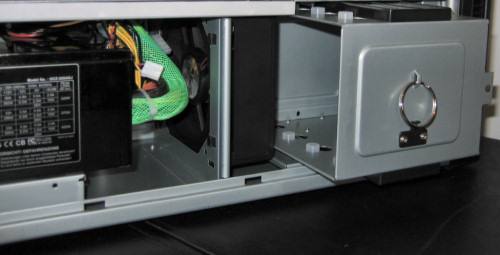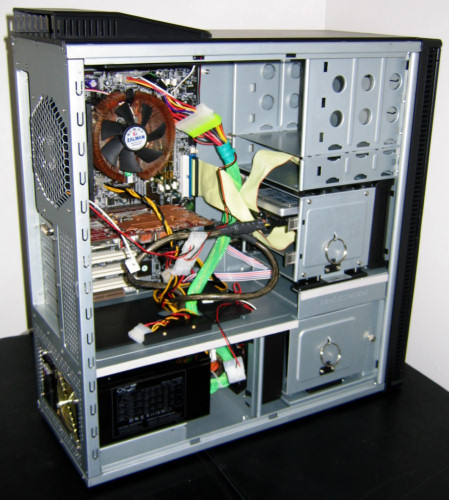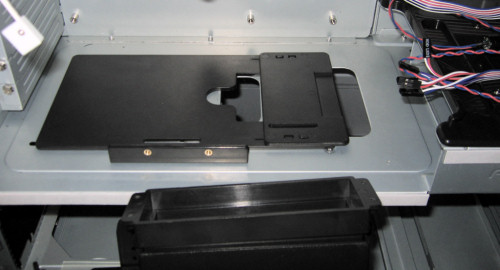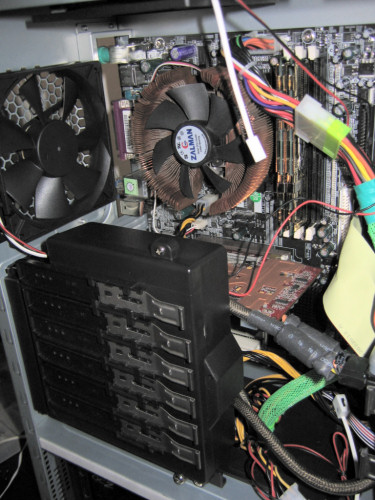Mid-Tower Mega Roundup
by Joshua Buss on September 8, 2005 12:05 AM EST- Posted in
- Cases/Cooling/PSUs
Antec P-180 (cont'd)
The P-180 ships with an unprecedented three 120mm fans, each of which has a switch identical to the ones that come with the Sonata. Out of the box, they are attached on the top panel pointing out, the rear panel pointing out, and the last is in the bottom chamber between where the power supply goes and the hard drive cage, directing air towards the power supply. Right away, we ran into a problem, however, with this third fan, as the power supply that we used for testing was too long to allow us to keep the fan where it was. To solve this problem, we made use of the case's fantastic customizability, and moved the fan to the other side of the bracket and turned it so that it was still blowing air towards the PSU. In this arrangement, it is no longer possible to put standard hard drives into the bottom drive cage, but there is still room for two in the upper cage anyway, so this was not a problem for us. In this picture, the bottom cage is half-way out, and the piece that holds the ring in place, both the upper and lower plastic rails on which the cage slides, as well as the tabs that the fan cage uses to hold the fan in place, are all visible.
The fact that we didn't use the included mounting bracket for the power supply is apparent from this picture as well, and the reason why is because we actually found it harder to fit out power supply into this bracket than just fastening it directly to the back plate. Ideally, this bracket's six rubberized strips could be used to keep vibrations from the power supply isolated, but our OCZ unit is rather quiet anyway.
As we mentioned earlier, the sheer design of this case - namely the decision to put the power supply at the bottom without inverting the motherboard - creates a potential problem: the motherboard power cables might be really tight, or unable to reach at all. With our Chaintech motherboard, we were actually testing just about the worst-case scenario, given that its power plug is at the very top of the board. Luckily, since we have to use the 24 to 20 pin adapter, our OCZ PowerStream power supply has enough cable to make the trip comfortably. This is definitely something to keep in mind, however, if one has an existing power supply and/or motherboard that they'd like to use in this case.
What is also visible in this picture is Antec's attempt at a system to isolate the two chambers thermally. The black plastic piece that the cables are going through can slide in two separate ways to make cable routing easier, but then slide back to provide a seal to keep the air moving only within each chamber.
Depending on one's particular setup, this cover could be used rather effectively or barely at all, depending on how many cables are needed to go through the two openings into the bottom chamber. For us, we must admit that we found the cover to be a bit more clumsy than useful, but this might not be the case for someone else.
One last piece to investigate with this case is the PCI card air duct. After everything else in the case was installed, the duct can be put into place and fastened through the back vent holes and at the bottom with two included bolts.
In our components picture on the previous page, the hole where an additional 80mm fan can be attached is visible, and it is this fan that would pull cool air from outside and direct it at the video and other cards to help keep them from getting too hot. Without the 80mm fan installed, the 120mm fans actually create enough suction to pull some air through this duct anyway - as long as they're on the medium or high speed setting - so purchasing an additional fan isn't totally necessary to make this duct usable. It also serves as the holder for the 5¼” drive rails, so losing them shouldn't be a problem; something that certainly can be in frequent traveling or uninstalling/reinstalling expeditions.
The P-180 ships with an unprecedented three 120mm fans, each of which has a switch identical to the ones that come with the Sonata. Out of the box, they are attached on the top panel pointing out, the rear panel pointing out, and the last is in the bottom chamber between where the power supply goes and the hard drive cage, directing air towards the power supply. Right away, we ran into a problem, however, with this third fan, as the power supply that we used for testing was too long to allow us to keep the fan where it was. To solve this problem, we made use of the case's fantastic customizability, and moved the fan to the other side of the bracket and turned it so that it was still blowing air towards the PSU. In this arrangement, it is no longer possible to put standard hard drives into the bottom drive cage, but there is still room for two in the upper cage anyway, so this was not a problem for us. In this picture, the bottom cage is half-way out, and the piece that holds the ring in place, both the upper and lower plastic rails on which the cage slides, as well as the tabs that the fan cage uses to hold the fan in place, are all visible.
The fact that we didn't use the included mounting bracket for the power supply is apparent from this picture as well, and the reason why is because we actually found it harder to fit out power supply into this bracket than just fastening it directly to the back plate. Ideally, this bracket's six rubberized strips could be used to keep vibrations from the power supply isolated, but our OCZ unit is rather quiet anyway.
As we mentioned earlier, the sheer design of this case - namely the decision to put the power supply at the bottom without inverting the motherboard - creates a potential problem: the motherboard power cables might be really tight, or unable to reach at all. With our Chaintech motherboard, we were actually testing just about the worst-case scenario, given that its power plug is at the very top of the board. Luckily, since we have to use the 24 to 20 pin adapter, our OCZ PowerStream power supply has enough cable to make the trip comfortably. This is definitely something to keep in mind, however, if one has an existing power supply and/or motherboard that they'd like to use in this case.
What is also visible in this picture is Antec's attempt at a system to isolate the two chambers thermally. The black plastic piece that the cables are going through can slide in two separate ways to make cable routing easier, but then slide back to provide a seal to keep the air moving only within each chamber.
Depending on one's particular setup, this cover could be used rather effectively or barely at all, depending on how many cables are needed to go through the two openings into the bottom chamber. For us, we must admit that we found the cover to be a bit more clumsy than useful, but this might not be the case for someone else.
One last piece to investigate with this case is the PCI card air duct. After everything else in the case was installed, the duct can be put into place and fastened through the back vent holes and at the bottom with two included bolts.
In our components picture on the previous page, the hole where an additional 80mm fan can be attached is visible, and it is this fan that would pull cool air from outside and direct it at the video and other cards to help keep them from getting too hot. Without the 80mm fan installed, the 120mm fans actually create enough suction to pull some air through this duct anyway - as long as they're on the medium or high speed setting - so purchasing an additional fan isn't totally necessary to make this duct usable. It also serves as the holder for the 5¼” drive rails, so losing them shouldn't be a problem; something that certainly can be in frequent traveling or uninstalling/reinstalling expeditions.














48 Comments
View All Comments
RupertS - Thursday, September 8, 2005 - link
The power supply is a good part of the total value of the case. Also, some of the cases may work better (cooling, sound) with the power supply they come with.Hard to compare prices like this.
johnsonx - Thursday, September 8, 2005 - link
Ditto that... this complaint has been leveled before of course:Anandtech should at least mention what power supply is (or can be) included with the case, and give some sort of subjective rating of same. For example, the Aspire case is most often available with a 420W power supply (usually a mere $15 or so more than the PS-less version), but I've heard it's crap... but maybe it isn't; I'd like Anandtech to tell me.
Likewise, the Sonata II ALWAYS (AFAIK) includes a SmartPower 2.0 450... doesn't that add significantly to the value equation? (granted, it'd be better if it were a TruePower 380 like the old Sonata, but a SmartPower 2.0 is nothing to scorn)
ElFenix - Thursday, September 8, 2005 - link
everyone should read the reviews on SPCR before setting up a system on this case. the reviews are very thorough and tests it in multiple configurations, and it turns out there are things you can do to improve its thermal performance by quite a bit (such as duct taping over the holes next to the power supply)flatblastard - Thursday, September 8, 2005 - link
Duct tape on a brand new case? I don't think so..... Well, I personally wouldn't do it, but for modders/OCers I guess it might make sense.fass mut - Thursday, September 8, 2005 - link
what's the link to the article?ElFenix - Thursday, September 8, 2005 - link
all three articles, the first is over main features, the second is an absolutely silent computer, and the third is more mainstream rigshttp://www.silentpcreview.com/article249-page1.htm...">http://www.silentpcreview.com/article249-page1.htm...
http://www.silentpcreview.com/article254-page1.htm...">http://www.silentpcreview.com/article254-page1.htm...
http://www.silentpcreview.com/article255-page1.htm...">http://www.silentpcreview.com/article255-page1.htm...
jonp - Thursday, September 8, 2005 - link
Doesn't an ATX extension cable for $4 cover the power supply to motherboard distance concern? Granted, Antec could have included it with the case; but it's NO big deal to resolve. Shouldn't be an issued when deciding.mjz - Thursday, September 8, 2005 - link
i hate lian li cases. I spent probably 200 dollars on their case (2 years ago) and it vibrates too much, the sound is pissing me off. I guess it can't handle my raptor or something.Tamale - Thursday, September 8, 2005 - link
I too agree that way too many of these cases are kinda ridiculous looking, but someone said it best when they said "the Eclipse must look better in person"... it really does. I liken it to those fancy cd players from places like brookstone and the sharper image..It's flashy, sure, but at least it's kinda 'classy flashy', if you know what I mean. If that kinda look still doesn't please you at all, there's always cases like the P-180 ;)
mkruer - Thursday, September 8, 2005 - link
Considering that I have a PC-V2000 Plus. I am in a unique position to voice my opinion for everyone reading this thread. I will say that yes the cases Lian Li cases are overly expensive, but considering that they are the only “all aluminum” case manufacture, and they have arguably the best design, they can get away with it. The main issues with an “all aluminum” case is that because aluminum is light then steal and yet does not have the absorbing capacity of plastic, aluminum as rule of thumb tends to be louder. However there are three things you can do o improve the noise ratio of the system. First is to install sound absorbing foam in the case. This will cut down on high pitched noise. Next is to install quieter fans. The Lian Li fans are good, but they are only about average in the noise to air ratio. Finally and this is the biggest thing. In order to cut down on the “wan wan” resonance sound coming form the case you need to suspend the drive is a sling and not it the mounting bays. This by far reduces the most noise.